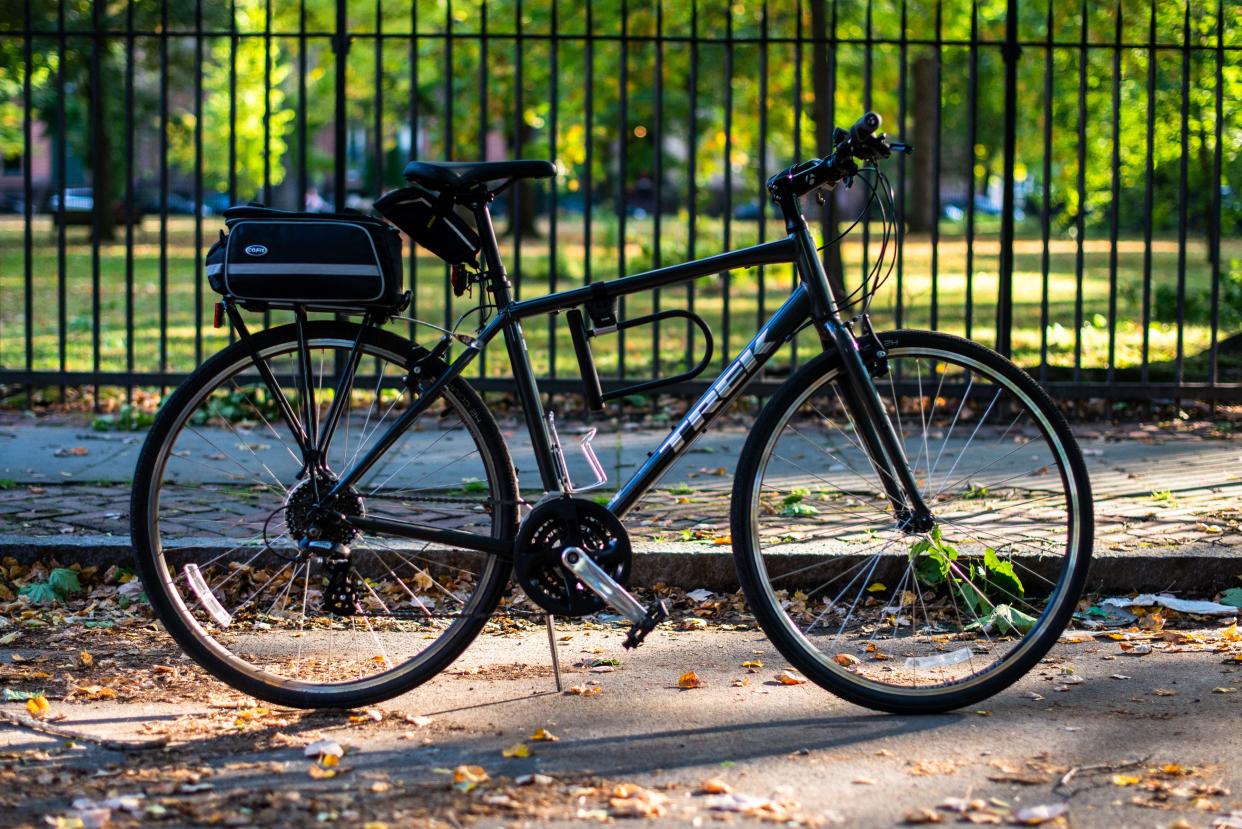I Always Wanted to Go Car-Free. Here’s How I Finally Did It.

Three years ago I moved to downtown Troy, NY, a smallish city floating amid a sea of suburbs. I had just gotten a new job, and with it, a new car. But I’d only been there a few months before I started to wonder: Could I live my life without a car? I yearned to stop spending time in traffic, and I wanted to align my lifestyle with my concerns about climate change. I’d never used my bike as a primary mode of transportation—as a teenager I drove around the New Jersey suburbs, and in college I relied on transit. The idea intrigued me.
There was one major obstacle: My job was out in suburbia, up a big hill and down a busy highway.

But then 2020 happened. When my job became remote in March, it hit me: This was my chance. A bike would be ideal transportation for the walkable city I live in. Getting to the few outliers—some grocery stores and doctors’ offices and the like—would be a challenge I could overcome.
So when my Subaru’s lease was up in July, I brought it back to the dealership. I thought I’d feel victorious for having conquered car dependency—but then I had second thoughts. Did I just make a big mistake? Was I giving up access to the hiking trails and day trips that made me love upstate New York? Still, when I hopped on my new bike a few weeks later, I knew instantly: It wasn’t a mistake.
My first ride electrified me. I’d gotten a Trek FX-1, an aluminum hybrid that was a huge upgrade from my 10-year-old Diamondback mountain bike. It felt like the difference between walking and running.
The logistics got a little harder as theoretical challenges became reality. I tried grocery delivery my first week, but when the bags ended up at the same address in a completely different city, I realized that wasn’t a reliable solution.
So I joined Capital CarShare, a local version of ZipCar, and used it when I needed to hit up Trader Joe’s. That worked fine, until the nonprofit shut down in December. Now I rely mostly on my partner—who has a car, but also a very busy work schedule—to shop for groceries every week or so.
A few times a month, I drive an Enterprise rental car two hours north to pursue one of my favorite hobbies: hiking in the Adirondacks. Yes, the $60 day rate plus fuel costs is hard to stomach, especially since the pandemic has rendered hiking a solo activity. But my car was costing me at least $400 a month, so the math still makes a lot of sense.
Plenty of other minor inconveniences remain: getting soaked when I have to ride in the rain; spending 45 minutes to bus and then bike somewhere I could have driven to in 20; struggling to transport anything larger than my pannier bags.
But I’ve found workarounds. I’ve become something of an expert at balancing awkward objects on my rear rack. I once balanced two gallons of paint without spilling them—a feat on my city’s potholed streets.
I keep an eye on the weather and try to slot in my errands in on sunnier, warmer days to avoid getting soaked or frozen. If I know I’ll be taking a longer bus trip, I pack a good book. (I’m still getting over the fear of my bike toppling off the bus rack and being crushed underneath.)
I’ve learned to leave a set of tools at both of the rental properties I manage, and I call in my parents for reinforcements if I have to transport, say, an appliance. Between grocery trips, I rely on nearby urban farms and the Troy Waterfront Farmers Market, stuffing my panniers with kale or collard greens.

Six months in, I still see my car-free life as an adventure—a new way of experiencing the place I call home. I haven’t reproduced every aspect of my formerly motorized existence, but my new lifestyle has brought unexpected benefits. It has introduced me to a network of riverside bike trails and local parks to explore that were right under my nose this whole time. And I’ve somehow won over my parents, who once lobbied heavily against this decision. They’re now some of my biggest allies.
My shift to two wheels also makes me feel like I’m doing my part, however small, to usher in a more sustainable future. And most important, it’s taught me that we have so much work to do to improve transportation options for people who have no choice but to go without a car.
→ No matter what you need to improve in your riding life, find it with Bicycling All Access!
From the start, I’ve treated this as an experiment: Could I pull off a bike lifestyle in a place where most people find the idea totally unworkable? For now at least, the answer is yes. Biking, even for just a half hour each day, brings me so much joy and energy; I don’t ever want to go back to relying on a car for my every move. We don’t know how much longer this work-from-home existence will last, but even if it ends, I owe it to myself to keep biking as a central part of my life.
You Might Also Like

